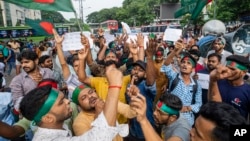Bangladesh-based fact-checkers examining social and mainstream media reporting on mob violence that swept the country after the ouster of Prime Minister Sheikh Hasina are debunking numerous accounts suggesting the nation’s Hindu minority were singled out because of their faith.
Those accounts appeared in outlets as far afield as Germany and the United Kingdom, where The Guardian newspaper reported on August 7 that “images of Hindus being lynched by mobs, temples set on fire and businesses looted have flooded social media in India, although the full scale of the attacks is unclear.”
In the United States, Bangladeshi American Hindus marched in Detroit with signs saying, “Stop killing Hindus," and Indian American lawmaker Ro Khanna went on Facebook and YouTube this month to demand that the U.S. government act to protect Hindus in Bangladesh.
The alarm was sounded most intensely in Hindu-majority India, where right-wing Hindu groups held rallies in Uttar Pradesh, Maharashtra and other states to protest what they said were “Islamist communal attacks on Hindus" in Bangladesh.
In Bangladesh itself, a sense of alarm was acknowledged by the interfaith Hindu Buddhist Christian Unity Council, which said in an August 9 open letter, “There is deep apprehension, anxiety and uncertainty among minorities across the country.”
The interim Bangladesh government headed by Nobel laureate Muhammad Yunus issued a formal statement shortly after taking office, saying, “The attacks on religious minorities in some places have been noted with grave concern.”
The statement, as quoted by Reuters, said the new Cabinet would “immediately sit with the representative bodies and other concerned groups to find ways to resolve such heinous attacks.”
There is no question that people died in the mob violence and that buildings were burned, but detailed analysis by Bangladeshi fact-checkers suggests that most of the victims were targeted because of their association with Hasina’s widely hated Awami League, not because of their faith. Hindus in Bangladesh had overwhelmingly supported Hasina and her party, which had close ties with India.
“After the fall of Sheikh Hasina, people directed their anger at the police and her party members, both Muslim and Hindu. So, the mobs, while attacking those affiliated to the party, attacked some Hindu households, too,” Minhaj Aman, lead researcher at Dismislab, a Dhaka-based fact-checking organization, told VOA in a telephone interview.
Qadaruddin Shishir, a Bangladesh-based fact-checker for the French news agency AFP, said, “Some hiding in the mobs might have targeted some households only to loot or steal household materials, as petty criminals do.
"But most attacks were politically motivated, targeting Muslims as well as Hindus who were linked to the Awami League. They did not stem from any religious reasons,” Shishir said.
The lack of religious motivation has been acknowledged by the Bangladesh National Hindu Grand Alliance, comprising almost two dozen Hindu religious organizations.
The alliance said it has counted 278 Hindu properties vandalized by mobs, but its secretary general, Gobinda Pramanik, told VOA that mobs attacked “five to seven times more” A.L.-supporting Muslim households after August 5.
“Almost all were politically motivated attacks. In the Indian media, they falsely termed them as communal anti-Hindu attacks. In Bangladesh, we do not have any communal tension between Muslims and Hindus,” Pramanik said by telephone.
“Some Hindus said that they were anxious about the safety of many Hindu temples from August 5, for two or three days; our Muslim brothers maintained vigil in front of many Hindu temples across the country,” he said.
Some of the most sensational images and accounts that emerged from the riots are erroneous or misleading.
Republic TV, an Indian outlet, broadcast video of a temple in Chittagong, which it said had been set ablaze by “Islamists in Bangladesh.” But the fact-checkers at Dismislab dismissed that report as unfounded.
“The caretaker of the temple told us that it had not been attacked at all. Furniture of an adjacent Awami League office was set ablaze by a mob and he did not know how the rumor of an ‘arson attack’ on the temple spread,” Aman told VOA.
VOA reached out to Republic TV to ask whether it still stood by its report but did not receive a response.
Another viral post on X claimed that a mob had set ablaze the house of Liton Das, a Hindu cricketer with Bangladesh’s national team, sharing a video of a burning house as “evidence.”
“But on fact checking, we found that the house of Liton Das had not been set on fire. The burning house in the video belonged to former Bangladeshi Muslim cricketer Mashrafe Mortaza, an A.L. [Awami League] member of Parliament, the police confirmed,” fact checker Shishir told VOA.










